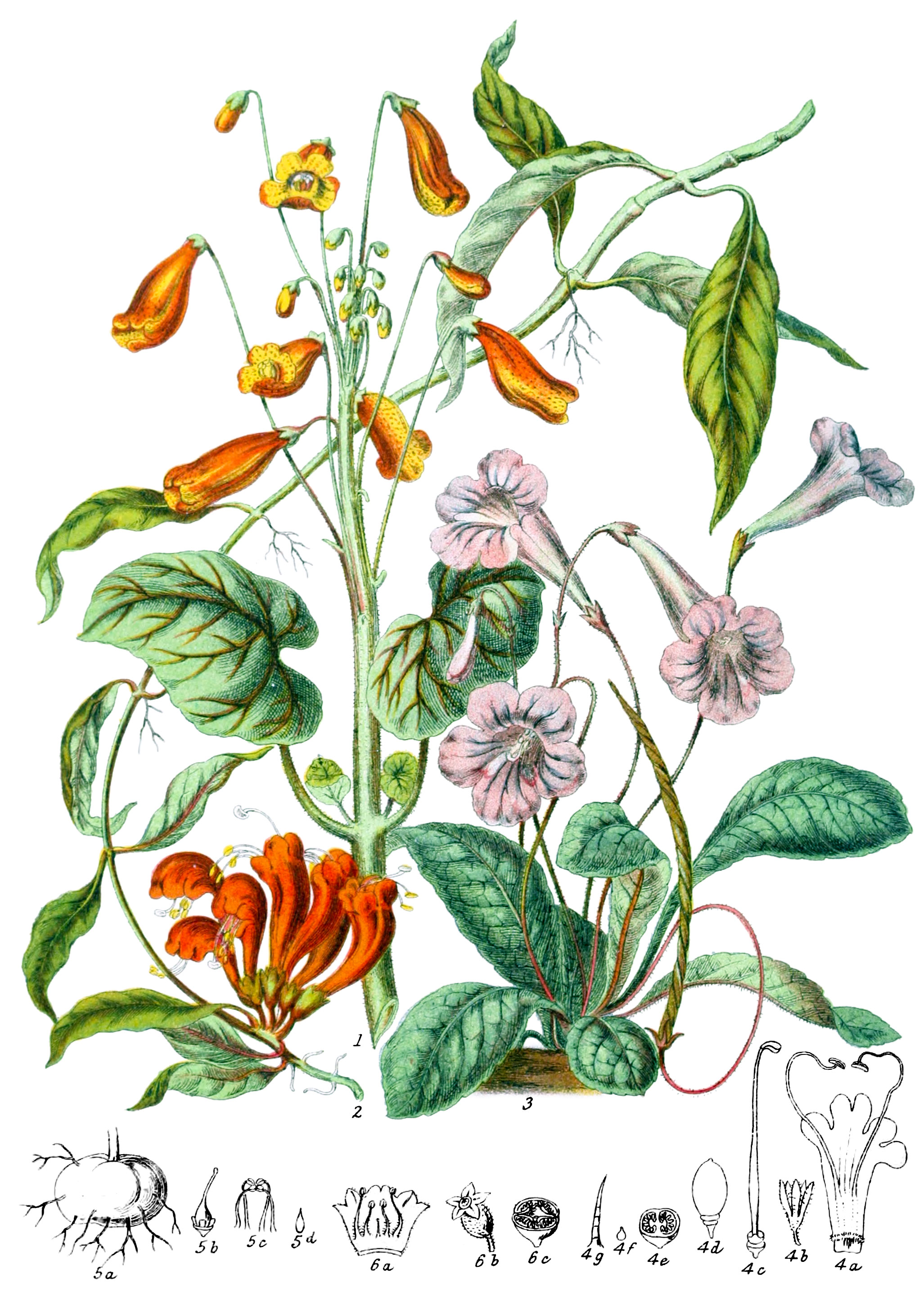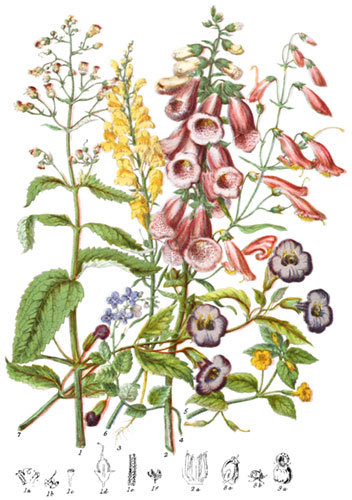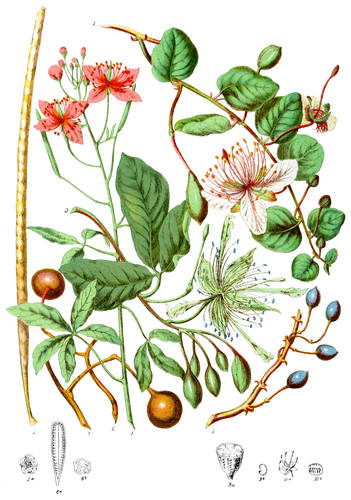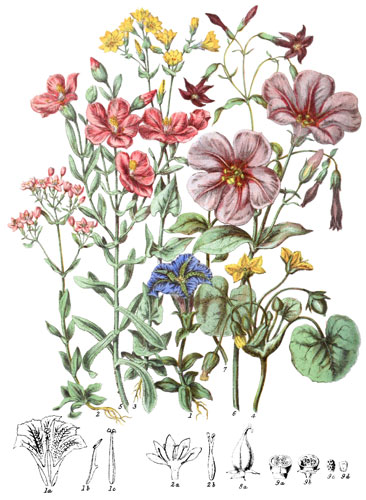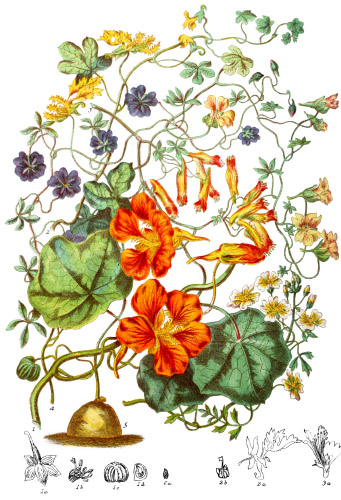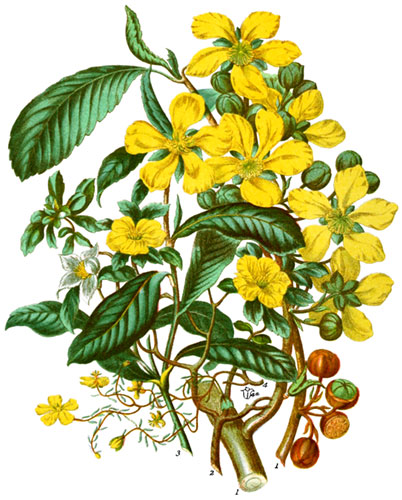Key characteristics
Shrubs and herbaceous plants, of a somewhat fleshy nature, and soft wood; sometimes having a climbing or creeping habit: some have tuberous roots. The leaves are generally rough or downy, without stipules, generally opposite, or in circles on the stalks. The flowers are usually in branching cluster, or panicles, rarely solitary. The calyx is partly adherent to the ovary, five-parted at the top. The corolla is composed of one petal, tubular, more or less, irregular, five-lobed. The stamens are two or four, one pair longer than the other; the rudiment of a fifth is sometimes present between the short pair: the anthers often cohere, are two-celled, and have an enlarged connective between the two lobes. The ovary is half above the calyx, one-celled, with two fleshy two-lobed projections from the edge; the disk is a fleshy ring studded with glands; the styles is continuous with the ovary, the stigma capitate or concave. The fruit is a dry capsule in Gesnera or succulent in Cyrtandra; one-celled, with numerous minute seeds fixed to the projecting plates: their outer covering is thin, with fine veins, sometimes clothed with long hairs, or bordered with a wide wing: they contain fleshy albumen, or none.
These plants have some affinity with Campanulaceæ, and in an outward appearance they partly resemble Bignoniaceæ.
Slightly aromatic and muscilaginous properties exist in a few of the fruits.
Select plants in this order
Not all plants listed are illustrated and not all plants illustrated are listed.
- Gesnera, which gives the name to this Tribe, was named after the famous Conrad Gesner, of Zurich, learned in all the branches of natural history, philosophy, and literature, called with Swiss Pliny: he died in 1565, after having restored the science of natural history to a higher position than it had held since the time of Aristotle and Theophrastus. He rounded the Botanic Garden and the Museum in his native city.
- The various speces of Gesnera adorn the fields and woods of Brazil and other hot countries of South America. The calyx and fruit yield a dye used by the natives for cotton and straw-work, and several other purposes. The succulent fruit is sweet and considered eatable.
- G. zebrina (1) is one of the most beautiful species in foliage and flowers.
- Æschynanthus grandiflorus (2) is an example of that section of the Tribe the seeds of which have no albumen, and the manner of growth being of a parsitical nature. It throws out rootlets at the joints, and is of an aspect very similar to that of an air-plant in the Orchis tribe.
- Streptocarpus (3) is remarkable for the long twisted capsule, differing from the rest of these plants in that respect The numerous seeds ripen well in this climate, and it is also of easy culture by dividing the roots; its delicately coloured flowers are extremely ornamental and elegant.
- Cyrtandra (4)* is an example of the flowers having only two stamens, and of the fruit being a berry; several species are natives of the Sandwich Isles, and of Java.
- Chirita is one of the numerous and beautiful genera of this tribe which abound in damp, warm valleys of the Himalayas; there also Didymocarpus and Calosacme flourish in considerable profusion, reaching to 8000 feet of elevation.
- Gloxinia is one of the most known of the South American genera, and has afforded several valuable plants for the embellishment of European conservatories; the flowers being of various shades of pale purple or pink.
- Sarmienta yields a useful emollient in Chili.
- Columnea scandens is a climbing plant of South America, the flowers of which secrete a large quantity of honey; it has therefore been named by the French colonists Liane à sirop.
- Klugia is a native of Mexico.
- Achimenes is a genus first introduced from Jamaica, and named Cyrilla pulchella, now known as A. coccinea.
- A. longiflora was discovered in ravines in Guatemala, and sent to England in 1840; the remarkable character of the formation of the flower is the extreme flatness of the corolla at the top of its long curved tube. It also affords an example of the change of colour which a flower undergoes during its expansion from the bud; in the early state, whilst the lobes of the corolla are small and still folded over each other at the top of the tube, they are of a pale yellowish hue, the tube a dull purple; when fuly grown and expanded, they acquire a bright purple, and the tube becomes a yellowish green colour.
- Alloplectus sparsiflorus is one of the most brilliant flowers of the evergreen woods of Rio Janeiro; the calyx and bracts are crimson, the corolla golden and extremely beautiful.
Locations
This Tribe is dispersed in each portion of the world, but in very different numbers. Gesnera and its immediate allies belong entirely to the Tropical and hot regions of America. Other genera are natives of Asia; Streptocarpus of the Cape of Good Hope; Fieldia of Australia; Ramondia and Haberlea are found in Europe.
Legend
- Gesnera zebrina. South America.
- Æschynanthus grandiflorus. Khorea.
- Streptocarpus Rexii. Cape of Good Hope.
-
- Cyrtandra staminea, Flower.
- Calyx.
- Pistil.
- Fruit.
- Section.
- Seed.
- Hair magnified.
-
- Tuber of Gesnera allophylla.
- Pistil with Glands.
- Stamens.
- Seed magnified.
-
- Flower of Gesnera grandiflora.
- Ovary with Calyx.
- Section of Fruit.
*4 was mentioned in the original description but only 4a–4g were illustrated.
Explore more
Posters
Decorate your walls with colorful detailed posters based on Elizabeth Twining’s beautiful two-volume set from 1868.
Puzzles
Challenge yourself or someone else to assemble a puzzle of all 160 botanical illustrations.
